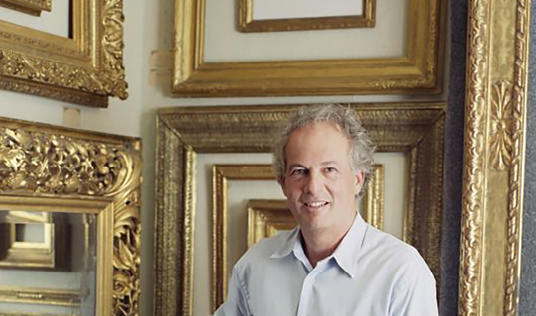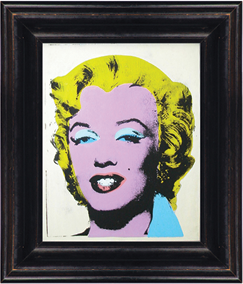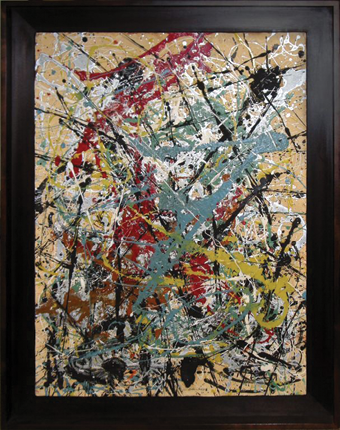- Home
- Media Kit
- Current Issue
- Past Issues
- Ad Specs-Submission
- Ad Print Settings
- Reprints (PDF)
- Photo Specifications (PDF)
- Contact Us

![]()
ONLINE


Eli Wilner at his frame gallery
The Value
of a Frame
Editors’ Note
Eli Wilner is a leading frame dealer, restorer, and collector, as well as an acknowledged and published authority on the art of framing. His publications include Antique American Frames: Identification and Price Guide, and The Gilded Edge. Wilner has framed over 10,000 paintings, including the spectacular frame for Washington Crossing the Delaware for The Metropolitan Museum of Art, and 28 paintings for the White House. Recently, Eli Wilner gave a presentation at the International Foundation for Art Research’s evening event “What Frames Can Tell Us,” held at Christie’s New York. Eli Wilner has been doing frame evaluations and appraisals since 1978.
Company Brief
Eli Wilner & Company (eliwilner.com) is a New York City gallery that specializes in European and American frames from the 15th century through the present. The company framed Emmanuel Leutze’s Washington Crossing the Delaware for The Metropolitan Museum of Art. For over two decades, Eli Wilner has created several hundred frames for the Old Master, Impressionist and Modern, American Art, and 19th Century European painting sales at Sotheby’s, Christie’s, Bonhams, and Doyle. Since 1983, Eli Wilner & Company has published over 100 articles about antique frames, and collaborated with curators from the Metropolitan Museum of Art, The Parrish Art Museum, the National Academy Museum, the Columbus Museum of Art, and many more, in their exhibitions of frames. Eli Wilner & Company recently evaluated a group of 271 frames that were donated to The Metropolitan Museum of Art by a prominent New York City art gallery. Eli Wilner & Company worked with the Appraisers Association of America to create the test that is given to certify appraisers of antique frames.
Where is the business today for Eli Wilner and where do you see future opportunities?
We are taking several tracks: One is to do more with the auction houses, meaning lending frames to the consignors without any upfront costs. We think we’ll be driving a lot more interest in frames.

An Eli Wilner-framed Andy Warhol
The issue we’ve had in the past is that we’ve marketed that way successfully but there has been a buyer’s resistance to having spent $20 million on a painting and finding out the frame is an extra $50,000.
Now the consignors will have zero costs upfront. After they’ve sold their painting – hopefully at a much higher price with our frame – they can use the proceeds to pay for the frame. The frame then goes to the buyer without any cost to them.
We’re also finding institutions around the world, particularly in America, who have budgets to at least restore the frames on their paintings even if they can’t reframe them. We’re making a much larger effort in restoring frames for museums.
The other major effort we’re making is in the Middle East. We’re in the midst of working out a partnership agreement with a royal family member in the United Arab Emirates that will lead to a retail presence in the Middle East and a much larger footprint in that area of the world. We’re evaluating opportunities in China at the moment as well. Several groups have contacted us about the possibility of franchising or having a hybrid franchise model in shopping centers around China.
Is it well understood what the right frame can mean to a painting and is it an education process to build that awareness?

An Eli Wilner-framed Jason Pollock
We have framed Warhols successfully, particularly through the auction houses, but we’re educating constantly. It’s a continuous battle to educate new collectors.
Is it hard to find product?
It’s very difficult to find great frames. We are now trying not to sell any period frames unless the client or institution demands it. We are making handcrafted replicas of the examples in my collection of 3,600 antique frames. Essentially, we’re using them as a library of surfaces and forms rather than as objects to sell. The business has become 85 to 90 percent replica frames, which is completely new.
How crowded is the market and how hard is it to cut through the noise and show your expertise?
I continue to use every form of advertising, and that helps maintain brand awareness. However, everyone says the most effective way to show what we’re about, as well as how we differentiate in our skill set and service, is through word-of-mouth, either through repeat clients or by using our former clients as references.
Would you talk about your facilities and the value of having these spaces?
We have our gallery on York Avenue and the frame creation and restoration studio in Long Island City. The studio is an extraordinary venue to showcase our craftsmanship to clients, museum groups, embassy groups coming to New York, and to Sotheby’s and Christie’s. We have about two visits a month where people learn about frames and try their hand in carving and gilding. We have found that to be invaluable in generating new clientele – and its fun.
Will much of the growth and opportunity come from international markets or is the U.S. still a strong place?
The U.S. remains a strong place for me. The art market is cyclical and is affected by current styles and collectors. The new collectors are gravitating towards contemporary art and have not yet realized the call for framing. However, there will always be a need for our core product.
How important is the corporate market and is there an opportunity to build a bigger business there?
Shareholders are not fond of the corporation spending money on art, so that’s not been a source of focus for us and neither have designers and decorators, which had been a big source of business. The major designers understand antique frames and will use them to complement modern design.
The entire geography of frames, framing, and collecting is continually refined, and that is to be expected. Every 30 years throughout history, there is a substantial change in how art and frames are perceived. In fact, during the Renaissance, many frames were worth more than the paintings. In the here-and-now, we are finding ways to continue to provide our services to refined collectors and museums, and exploring how we can satisfy the growing need for our work overseas.•